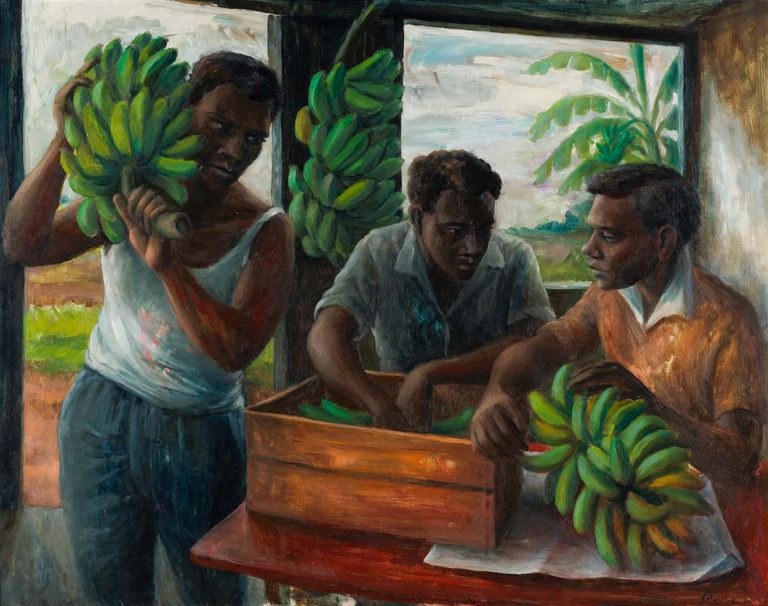We acknowledge the Traditional Owners of the land on which the Queensland Art Gallery | Gallery of Modern Art stands and recognise the creative contribution First Australians make to the art and culture of this country.

Margaret Olley / Australia 1923–2011 / The banana cutters 1963 / Oil on board / 95 x 121cm / Purchased 2014 with funds from Drs Philip and Lenna Smith through the Queensland Art Gallery | Gallery of Modern Art Foundation / Collection: Queensland Art Gallery | Gallery of Modern Art / © Estate of Margaret Olley
Margaret OlleyThe banana cutters 1963
On Display: QAG, Gallery 12
Margaret Olley made traditional still-life and interior subjects uniquely her own. A number of her works from her Brisbane period drew inspiration from the human figure.
The banana cutters 1963 is historically significant because of its combination of Queensland subject matter and exemplary figure painting. The work was awarded first prize at Brisbane’s 1963 Royal National Agricultural and Industrial Association of Queensland Exhibition of Art.
The banana cutters follows this figure-and-still-life format, but with a distinctly masculine working subject. The male figures are depicted with an innate, quiet dignity that is enhanced by Olley’s choice of harmonious colour relationships.
The workers may be of South Sea Islander descent, and the painting may refer to the history the South Sea Islanders recruited — or abducted — from across Melanesia between 1863 and 1904 to work in Queensland and northern New South Wales.
Margaret Olley was born in 1923 in Lismore, New South Wales. Her family moved to Tully in North Queensland and to Murwillumbah in northern New South Wales before she was sent to board at Somerville House, a prominent private girls’ school in South Brisbane. There, with the mentorship of art mistress Caroline Barker, she was inspired to consider a career in art.
She enrolled briefly at the Brisbane Technical College and completed her training in 1945 at the East Sydney Technical College. Her first solo exhibitions were held in 1948, at the Macquarie Galleries, Sydney and the Moreton Galleries, Brisbane. Olley’s growing popularity made her an attractive subject for artists, and William Dobell’s portrait of Olley in the 1948 Archibald Prize caused a sensation. In 1949 she travelled to England, studied at La Grande Chaumière in Paris in 1950 and she also travelled to Italy, Spain and Portugal. Olley held exhibitions at the Redfern Gallery, London and the Galerie Paul Morihien, Paris in 1952.
When she returned to Australia, Olley established herself in Brisbane, living at her mother’s home in Morry St, Hill End. In 1959 she opened an antique shop in the inner suburb of Buranda. She later purchased a terrace house and an adjacent former hat factory in Duxford St, Paddington in Sydney, which she renovated to use as her studio. This house became almost as famous as the artist herself, featuring richly coloured walls and packed with thousands of objects, many appearing in her still-life paintings. She retained the family home in Brisbane, although the house was sadly destroyed by fire in 1980, resulting in the loss of many of Olley’s early works, photographs, and objects from her travels.